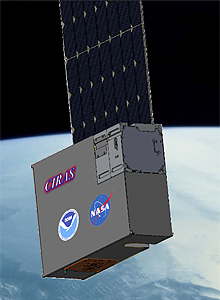Thank you very much for visiting Gunter's Space Page. I hope that this site is useful and informative for you.
If you appreciate the information provided on this site, please consider supporting my work by making a simple and secure donation via PayPal. Please help to run the website and keep everything free of charge. Thank you very much.
CIRAS

CIRAS [JPL]
CIRAS (CubeSat Infrared Atmospheric Sounder) is a technology demonstration mission of three key infrared (IR) sensing and cryogenic technologies designed to reduce the size and cost of future space-borne IR remote-sensing instruments and serve as a pathfinder for EON-IR (Earth Observation Nanosatellite - Infra Red).
It will advance the technology readiness level of the High Operating Temperature Barrier Infrared Detector, Coaxial Micro Pulse Tube CyroCooler and the Mid-Wavelength Infrared Radiance Grating Spectrometer to a seven.
CIRAS will measure upwelling infrared radiation of the Earth in the MWIR region of the spectrum from space on a CubeSat. The observed radiances can be assimilated into weather forecast models and be used to retrieve lower tropospheric temperature and water vapor for climate studies. Multiple units can be flown to improve temporal coverage or apply different spectral ranges to look at other atmospheric trace gases in the infrared including CO, CO2, CH4, O3, and SO2. Higher spatial resolution units can be developed with the same optics and detector array, with a lower detector operating temperature and consequently more power from the spacecraft. Higher spatial resolution and formation flying can provide new data products including 3D motion vector winds.
CIRAS incorporates three new instrument technologies:
- The first is a 2D array of High Operating Temperature Barrier Infrared Detector (HOT-BIRD) material, selected for its high uniformity, low cost, low noise and higher operating temperatures than traditional materials. The detectors are hybridized to a commercial ROIC and commercial camera electronics and dewar package.
- The second technology is a Lockheed Martin Coaxial Micro Pulse Tube (MPT) cryocooler. The MPT offers high cooling capacity in a CubeSat compatible package and its flexure bearing technology enables significantly longer mission life.
- The third technology is an MWIR Grating Spectrometer (MGS) designed to provide imaging spectroscopy for atmospheric sounding in a CubeSat volume. The MGS has no moving parts and is based on heritage spectrometers including the OCO-2 and the JPL/Ball Spaceborne Infrared Atmospheric Sounder (SIRAS) IIP.
JPL will also develop the mechanical, electronic and thermal subsystems for CIRAS, with satellite components procured from Blue Canyon Technologies. The integrated system will be a complete 6U CubeSat capable of measuring temperature and water vapor profiles with good lower tropospheric sensitivity. The CIRAS is the first step towards the development of an Earth Observation Nanosatellite Infrared (EON-IR) capable of meeting the replacement needs of the CrIS, including both the MWIR and LWIR regions of the spectrum.
It was selected by for development by the NASA InVEST Project and in 2016 by NASA's CubeSat Launch Initiative (CSLI) program by the CubeSat Launch Initiative (CSLI) to be launched as part of the ELaNa program.
| Nation: | USA |
|---|---|
| Type / Application: | Technology |
| Operator: | Jet Propulsion Laboratory (JPL) |
| Contractors: | Jet Propulsion Laboratory (JPL), Blue Canyon Technologies |
| Equipment: | High Operating Temperature Barrier Infrared Detector, Coaxial Micro Pulse Tube CyroCooler, Mid-Wavelength Infrared Radiance Grating Spectrometer |
| Configuration: | CubeSat (6U) |
| Propulsion: | None |
| Power: | Deployable fixed solar array, batteries |
| Lifetime: | |
| Mass: | +6 kg |
| Orbit: |
| Satellite | COSPAR | Date | LS | Launch Vehicle | Remarks | |
|---|---|---|---|---|---|---|
| CIRAS | - | 202x | (via NASA ELaNa program) | with ? |
References:
- Thomas S. Pagano: CubeSat Infrared Atmospheric Sounder (CIRAS)
